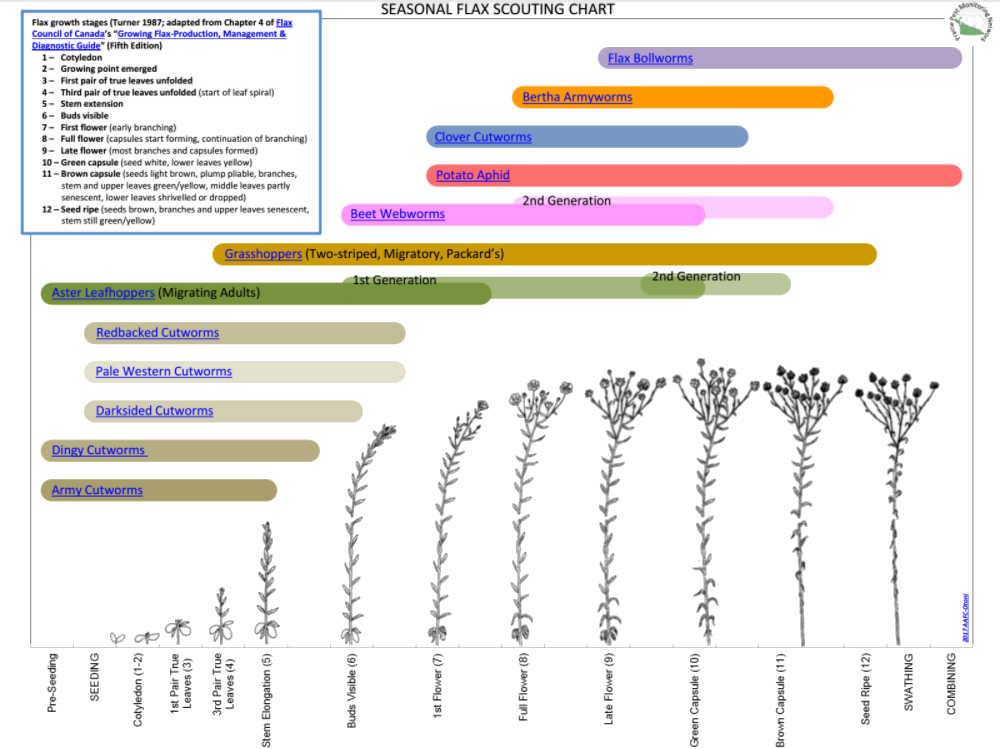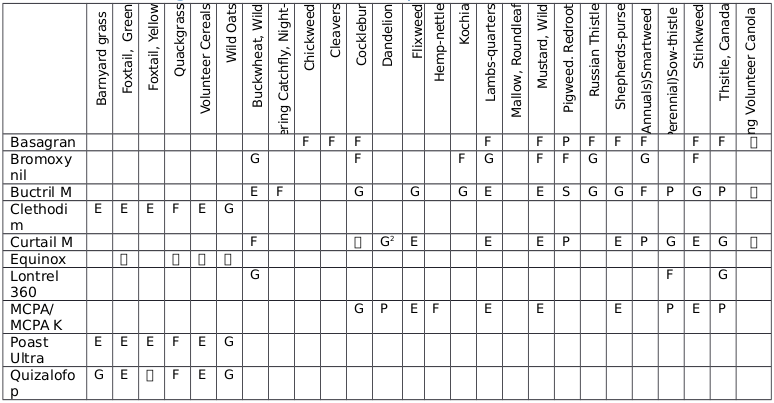Flax TIPS: Emergence Monitoring: Issues for 2017
According to most recent Provincial crop reports, seeding is 57% complete in Alberta, 81% complete in Saskatchewan and 90% complete in Manitoba. As seeding activities come to a completion, it is important to be checking emergence progress. There are a number of issues to watch for, here we will focus a couple issues for spring 2017.
Cutworms
There are six species of cutworms that affect flax mid-May to early-June (see Flax Scouting Chart). Whole field scouting and properly identifying cutworm species is the first step to effective management. The species of cutworms that affect flax vary in their feeding habits and distribution, some are above-ground feeders, and others are below-ground (Table 1). Cutworms are typically “patchy” in distribution in a field, and generally feed at night which can have implications for spray decisions. For example, it may be more economical to only spray patches rather than the whole field, and insecticide applications may be most effective when applied into the evening, depending on the product, when some species of cutworms are emerging from the soil to feed.
Table 1. Cutworms Affecting Flax
| Feeding Habit | Look For | Geography | Notes | |
|---|---|---|---|---|
Pale Western Cutworm 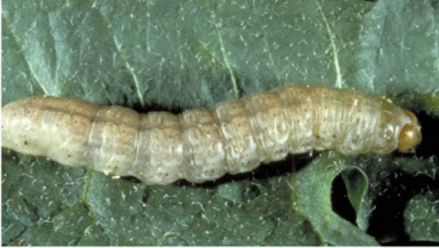 |
Below-ground; May pull seedlings below ground | Missing plants from rows; cut off plants; bare patches; Sandy hill tops and south facing slopes | Southern Alberta and Saskatchewan | Prefers cereals; Apply insecticides late in the evening |
Dingy Cutworm 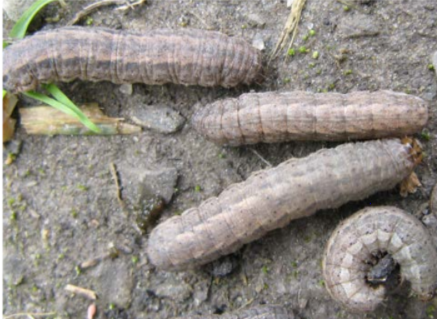 |
Above-ground; also climbing; Consumes leaves, rarely stems | Wilted; notched leaves | Wide distribution | Manage fields in fall to prevent females from laying eggs |
Darksided Cutworm  |
Above-ground; Climbing; Consume leaves and stems | Wilted; notched leaves and stems; cut off plants | Wide distribution | Feeds at night on leaves and stems. |
Army Cutworm 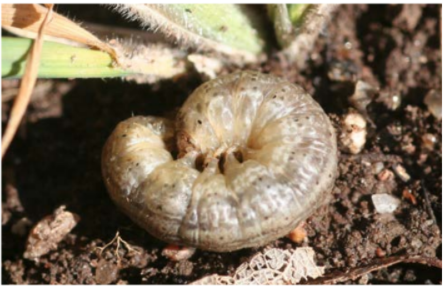 |
Above-ground; Consumes leaves | Wilted; notched leaves | Southern Alberta; Sometimes southern Saskatchewan; Rare in Manitoba | Feeds early in the season, i.e. winter cereals |
Redbacked Cutworm 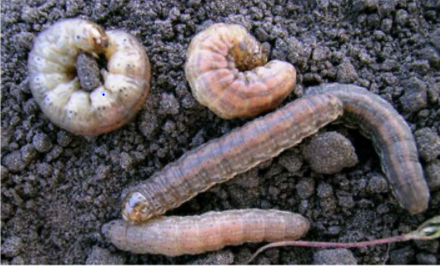 |
Above or below-ground; Consumes leaves; May pull seedlings below ground | Wilted; notched leaves and stems; cut off plants; missing plants | Wide distribution; Prefers moist soil (i.e. black soil zones) | Apply insecticides late in the evening |
Clover Cutworm 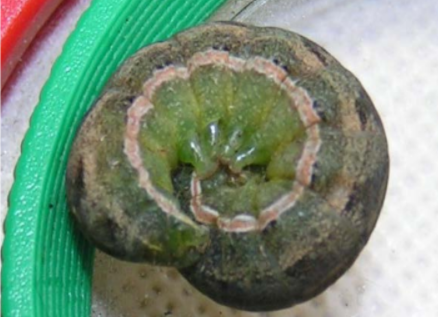 |
Above-ground; Climbing; Consume leaves, sometimes stems | Bleaching in plants in some parts of field | Wide distribution | Prefers canola, mustard, flax; Similar appearance to Bertha Armyworm |
Adapted from “Cutworm Pests of Crops on the Canadian Prairies: Identification and Management Field Guide” (https://drive.google.com/file/d/0B_Pg-Nb5Pst1VnFuZk1hb25ZWk0/view).
Scouting
-
Look for signs of plant damage, missing plants from rows or bare soil. Scout at outer edges of patches where cutworms are currently feeding.
-
Use a shovel or trowel to search the top 5 cm of soil of a known area (e.g. 50 cm x 50 cm, or 0.25 m2). If sample area was 0.25 m2, multiply cutworm count by 4 to get the cutworms/ m2.
-
Repeat in several affected areas of the field (if considering patch spraying).
-
The economic threshold of cutworms in flax is 4 – 5 cutworms/ m2.
Look for signs of plant damage, missing plants from rows or bare soil. Scout at outer edges of patches where cutworms are currently feeding.
Use a shovel or trowel to search the top 5 cm of soil of a known area (e.g. 50 cm x 50 cm, or 0.25 m2). If sample area was 0.25 m2, multiply cutworm count by 4 to get the cutworms/ m2.
Repeat in several affected areas of the field (if considering patch spraying).
The economic threshold of cutworms in flax is 4 – 5 cutworms/ m2.
Control Options
Coragen, Decis 5EC, Matador, Pounce/ Perm-UP/Ambush and clopyrifos are registered for the control of cutworms in flax. For more information check your local guide to crop protection.
Products vary in their specificity and mode of entry (e.g. ingestion versus contact) which will affect application timing, among other factors. For example, products that work primarily through contact require knowledge of when cutworms are above ground and feeding in order to get coverage on the insects, as compared to products that work though ingestion, which require good coverage on the crop. Non-specific products may have unintended effects on beneficial insects such as pollinators. Appropriate scouting should take place to determine the distribution of cutworms in the field. It is often more economical to apply insecticides to these areas only.
Timing of application is also important. If cutworms are 25 to 50 mm (1 to 2 inches) in length, depending on the species, they may have reached the end of their development cycle. If the gut colour of squished cutworms is brown, not green, then they have stopped feeding and are molting between instars or about to pupate. If about to pupate, this means they have consumed as much as they will consume and insecticides are not warranted as no further damage will occur. However, the final large instars eat the most, so there is a risk in not treating infestations based only on large larvae sizes if they are still not approaching pupation.
Cutworms are susceptible to a variety of parasites, predation, and pathogens which can reduce the severity of cutworm outbreaks.
For more information on cutworms, visit the Prairie Pest Monitoring Network Blog: Cutworm Corner.http://prairiepestmonitoring.blogspot.ca/p/cutworm-corner.html
Interaction of Environment on Herbicide Performance, Crop Safety & Weed Efficacy
Dry spring conditions could have implications for both crop and weed emergence this spring. Spring burn off applications may have had a limited effect, depending on the species, as early season flushes of weeds may be limited by lack of moisture. This could mean weeds will be germinating at the same time as flax seedlings, increasing early season competition. Emergence monitoring should include weed scouting to identify and plan for timely and appropriate herbicide applications. Below you will find considerations of weather conditions on herbicide performance, crop safety and weed efficacy.
Group 1 herbicides – graminicides
-
Weed efficacy is reduced when grassy weeds are not growing well (i.e. environmental stress).
-
As flax is very tolerant to Group 1 herbicides, application usually results in minor to no crop injury.
Group 6 herbicides (Bromoxynil and Basagran) – contact herbicides
-
Better efficacy on weeds under warm/sunny conditions.
-
If conditions are too cool and weeds too large, weeds can out-grow the herbicide injury and as such only be suppressed.
-
If conditions are too warm (> 28 o C), herbicide application can injure flax seedlings and in the worse-case scenario, can kill the main growing point. The plant often regrows from lateral buds resulting in two or more stems.
-
Flax growth staging is important as well. Do not apply when flax is < 2 inches in height as this may result in damage to the growing point.
Group 4 herbicides (MCPA, Curtail M) – growth regulators
-
Addition of MCPA to bromoxynil (Buctril M) provides better control of larger weeds in cooler conditions.
-
Although flax has good tolerance to Group 4 herbicides, it is not immune and damage may occur.
-
Under warm and humid conditions, flax may rapidly uptake Group 4 herbicides and this may result in plant damage. The damage may resemble ‘simulated drought’ symptoms from restricted water transport to the top of the plant (including bolls and seeds).
-
Curtail M, which is a mixture of two Group 4 herbicides, is typically safe on flax, but if used under hot conditions or late (flax > 6 inches), may result in wilting, stunting and flower abortions.
-
Lontrel (one of the components of Curtail M) is very safe on flax, but has a limited spectrum of weeds controlled.
Post-emergent Weed Control Options in Flax
Adapted from the Saskatchewan/Manitoba Guide to Crop Protection. Control is rated as ‘P’ Poor; ‘F’ Fair; ‘G’ Good; ‘E’ Excellent. Registered for control. Some products may have additional weeds on the label. Check guide for complete list. Always check the herbicide label before applying any herbicide.

